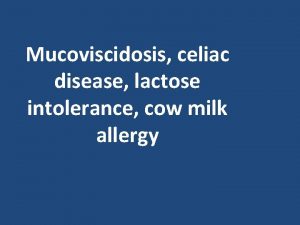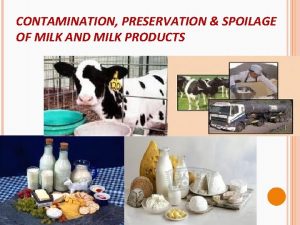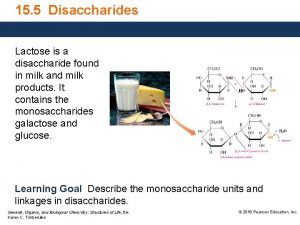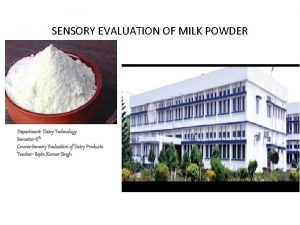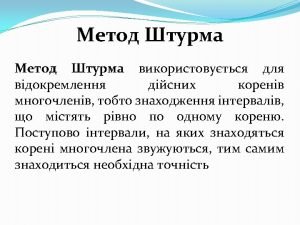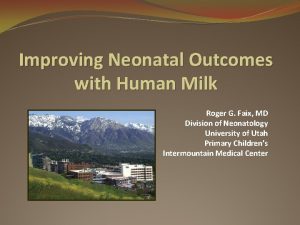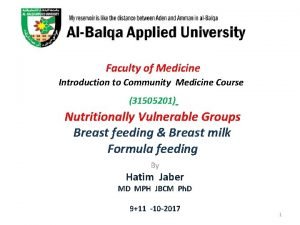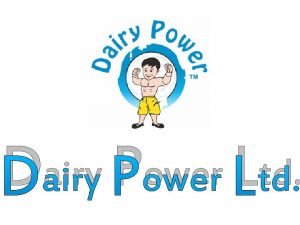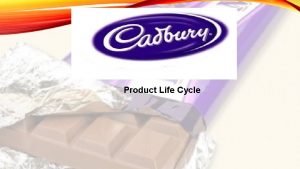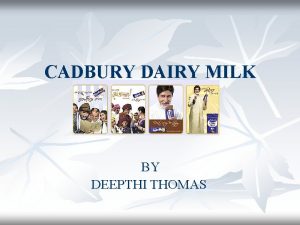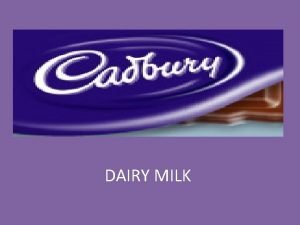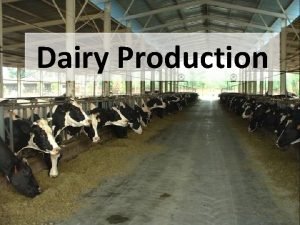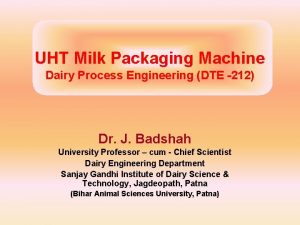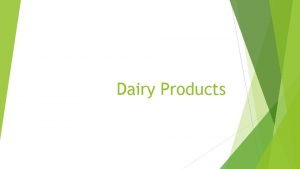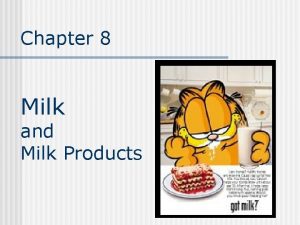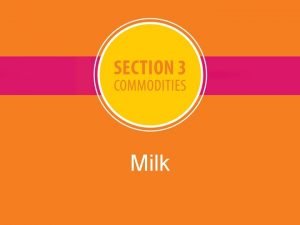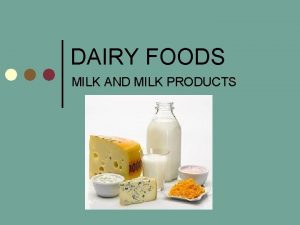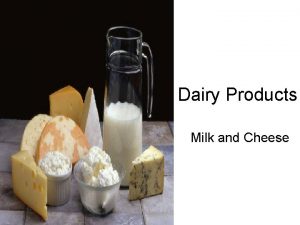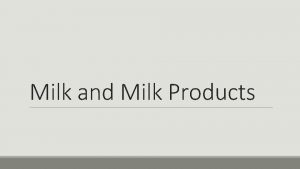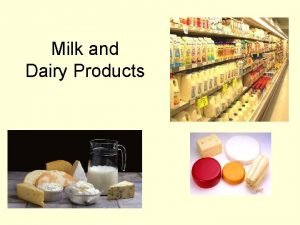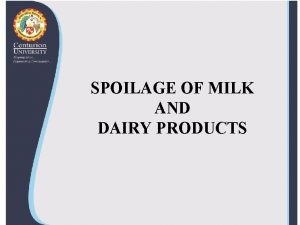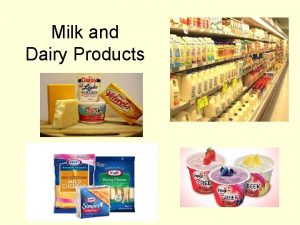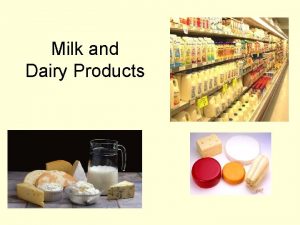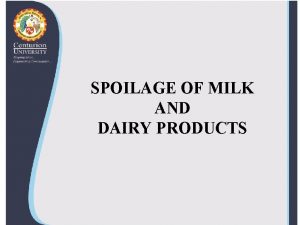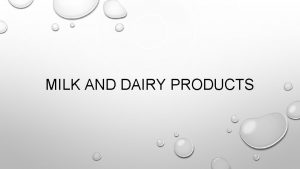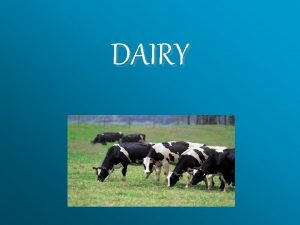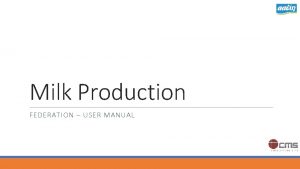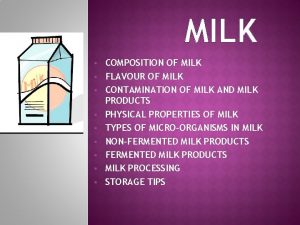Dairy Products n n Dairy Products include milk
















- Slides: 16

Dairy Products

n n Dairy Products include milk, yogurt, cheese, ice cream, and pudding. Cream, butter, sour cream are also dairy products but they also have a large amount of fat.

Milk One of the most well-liked foods. n n n Pasteurization-milk is heat treated to destroy harmful bacteria Homogenizationmechanical process that prevents the cream from rising to the surface of milk. Lactose-Intolerantmilk sugar often causes problems for some people.

Types of Milk n n n Whole-3. 3% fat by weight with 48% of the calories from fat. Low-Fat-is 1 -2 % fat by weight with 16 -38% calories from fat. Skim-Contains only a trace of fat. n Imitation milk-not a dairy product

Other Types of Milk n n Buttermilk-has a tart, buttery flavor and smooth, thick texture. It was originally the fluid left after the cream was churned into butter. Now it is made from cultured low fat milk. Chocolate Milk-has chocolate or cocoa and sweetener added. n n n Nonfat Dry Milk-a powdered form of skim milk. Evaporated milkcanned whole or skim milk that contains only half the amount of water. Sweetened Condensed Milk-concentrated sweetened canned milk. Used for desserts and candy.

Other Types of Milk n Dairy Products made from milk to which helpful bacteria have been added are cultured milk dairy products. n Examples: n n n Yogurt Buttermilk Kefir- has been used for centuries in the Middle East and Russia.

Butter n Churning cream creates butter.

Storing Dairy Products n n All dairy products are highly perishable. Cover and store in the coldest part of the refrigerator. Keep containers tightly covered to prevent contamination and off flavors. Keep milk away from light-which destroys the riboflavin in the milk. Store milk in the original container.

Cheese n n Cheese is a concentrated form of milk. To make cheese, milk is coagulatedthe curd (solid part) is separated from the whey (liquid part)

Kinds of Cheese n Unripened Cheese n n Have not been allowed to age or ripen. Examples n n Cottage cheese Cream cheese Farmer’s Cheese Ricotta Cheese n Ripened Cheese n n n Made with controlled amounts of bacteria, mold, yeast, or enzymes. Has been allowed to ripen. Aging can be from two weeks to two years. Examples n n Cheddar Swiss Mozzarella Colby

Process Cheese n n Processed Cheese- products that are made from other cheeses, such as Velveeta Cheese. Processed cheese blends more easily in cooked cheese dishes than natural cheese because of the emulsifiers (holds things together) it contains.

Cooking with Milk and Cream n Because milk is protein food, special care must be taken during cooking to prevent the following: n Scorching-burning that results in a color change. To prevent, use low heat. n Curdling-high temperature, acids, tannins, enzymes and salts cause the milk proteins to coagulate and cause clumps. Use a low temperature and fresh milk to prevent.

Whipping Properties of Cream n Sugar decreases the volume and stiffness of whipped cream You should add the sugar after the cream is thick.

Preparing Common Milk Based Foods n n White Sauce-starch thickened milk product. Classic White Sauce is prepared with a roux- a cooked paste of flour and fat. The ratio is one part flour to one part fat. n n Melt the fat over low heat. Stir in flour to form a roux. Stir in milk. Stir constantly as you cook the mixture over medium heat until it thickens into a smooth sauce. You can use a slurry (a liquid mixture of milk and flour) to thicken a white sauce. http: //www. youtube. com/watch? v=Vl. Mtb. X-0 ABA

Food Science Principles of Cooking Puddings n n All puddings require the use of moderate cooking temperatures to prevent scorching and over coagulation of the eggs. When you use eggs in puddings, you should first add a small amount of the hot pudding to the beaten eggs. You can add the diluted egg mixture to the rest of the hot pudding. Eggs added directly to the hot mixture will coagulate into lumps. This is called tempering the eggs. http: //www. foodnetwork. com/videos/how-totemper-eggs-video/85017. html

Cooking with Cheese n n n Like all high protein foods, heat can adversely affect cheese. If you cook cheese at too high of a temperature, the cheese will become rubbery and tough. When the proteins in cheese overcoagulate, the cheese becomes tough and rubbery and the fat may separate.
 Milk for toddlers with milk allergynon dairy
Milk for toddlers with milk allergynon dairy Contamination of milk and milk products
Contamination of milk and milk products Lactose is a disaccharide found in milk
Lactose is a disaccharide found in milk Sensory evaluation of dairy products
Sensory evaluation of dairy products #include stdio.h #include conio.h #include stdlib.h
#include stdio.h #include conio.h #include stdlib.h #include stdio.h int main()
#include stdio.h int main() Difference between human milk and cow milk
Difference between human milk and cow milk Human milk vs cow milk
Human milk vs cow milk Dairy power ghee
Dairy power ghee Cadbury dairy milk product life cycle
Cadbury dairy milk product life cycle Milk yield and composition in dairy cows ppt
Milk yield and composition in dairy cows ppt Cadbury dairy milk advert
Cadbury dairy milk advert Objectives of milk dairy visit
Objectives of milk dairy visit Ls strip tetra pak
Ls strip tetra pak Bestmilk a typical profit maximizing
Bestmilk a typical profit maximizing
